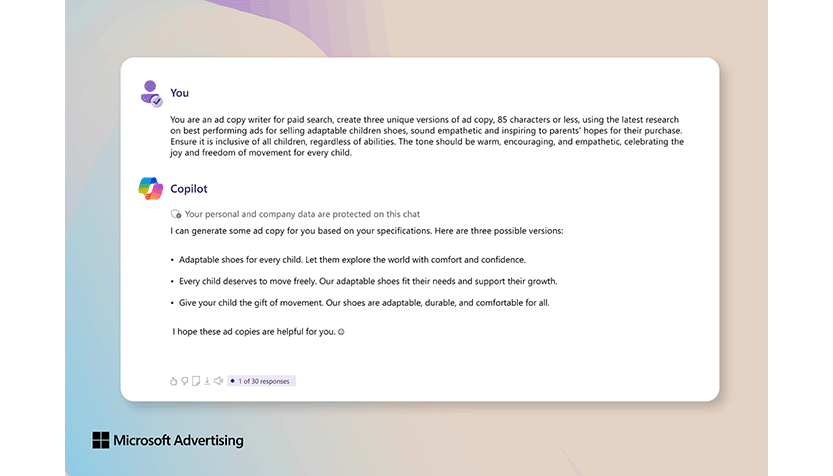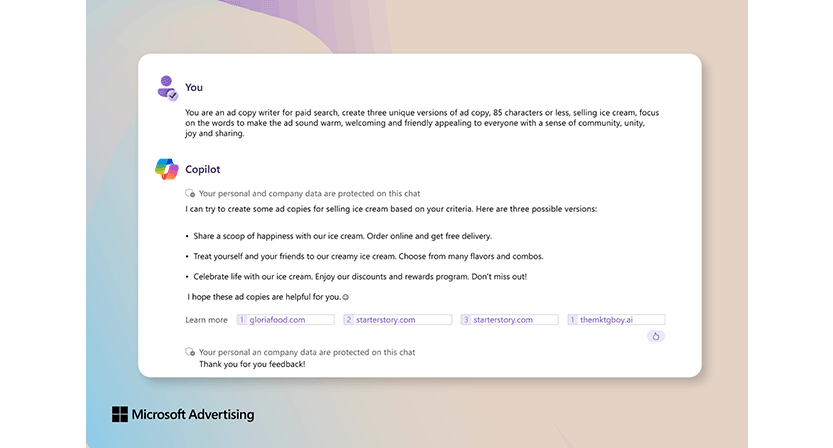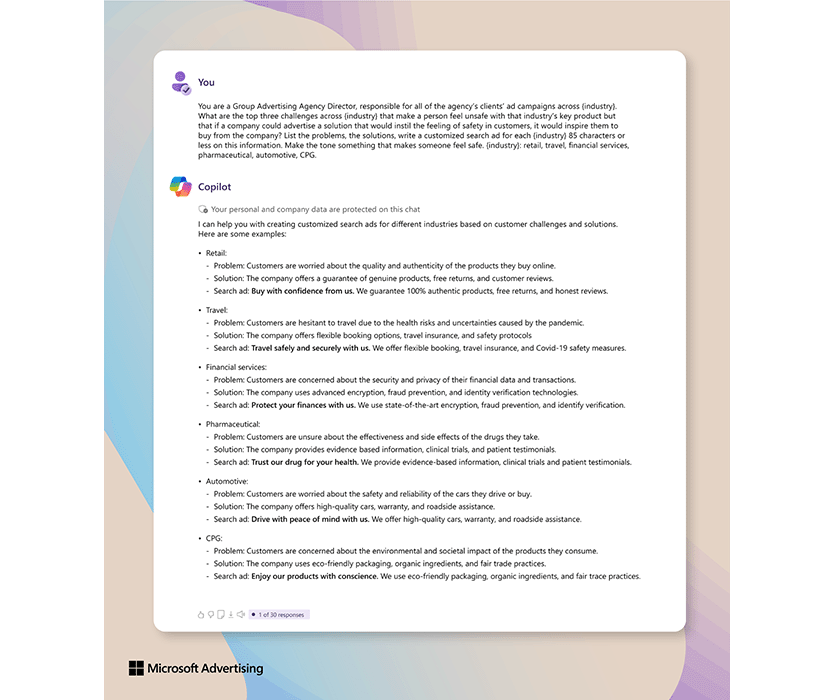Inclusive prompt engineering: How to boost your ad performance with better copywriting

As an advertising professional with an enormous list of to-do’s and aggressive performance goals to hit, making sense of what AI prompt engineering can do for your advertising efforts should be near the top of your list. Whether you own a business, lead an ad team, or manage campaigns directly, learning the skill of prompt engineering can help you:
- Save time
- Reduce labor-intensive tasks
- Create innovative insights and strategies
Using Microsoft Copilot, your everyday AI companion, increases your ability to generate creative at unprecedented speed and scale, enabling you to produce advertising assets that represent a wide spectrum of customer scenarios while simultaneously helping to deliver unparalleled personalization. Whether you’re an SMB or a marketing expert within a Fortune 500, generative AI has become a valuable tool to creatively make customer connections and build trust. This technology not only increases productivity and enhances creativity, but also introduces the possibility to create more diverse and inclusive content when you have a set of inclusive advertising insights to apply. To make the most out of this, we’re sharing some guiding principles and ideas to aid your transformation journey.
And with our inclusive advertising insights from our Microsoft Advertising Psychology of Inclusion and Effects in Advertising research, we’re empowering you to deliver inclusive advertising with generative AI that can:
- Increase brand trust, love, and loyalty (#1 indicator of future revenue growth).
- Boost customer purchase intent by as much as 23-points.
By combining these three powerful tools – Microsoft Copilot’s generative AI, strategic prompt engineering skills, and inclusive advertising insights – you can aim to outperform your baseline ad campaign performance metrics while saving time and effort. A Work Trend Index Special Report cited people who use Microsoft Copilot are 70% more productive, 29% faster overall in a series of tasks, and 85% said Copilot helps them get to a good first draft faster.
Whether you’re immersed in generative AI or just starting out, we’ll outline our unique perspective on how inclusive advertising insights applied to prompt engineering can boost your ad performance with better ad copywriting. Additionally, we’ll help you understand how the intersection of prompt engineering and applied inclusive insights can uplevel your professional skillset, empowering transformation for new and unique value to your business and clients. Ultimately, our goal is to help you optimize your return on effort and deliver a boost in ad performance.
The five key ideas for inclusive prompt engineering
First idea – There’s a blueprint for a great prompt for ad copy creation
There are several ways we think about AI prompt engineering in advertising. Like any skill set, we predict we’ll keep figuring out new and ingenuous ways of using this tool as it evolves. For now, let’s start with the blueprint for a great prompt for ad copy and build upon real examples. There are 6 key elements to include when writing a great prompt for ad copy:
- Task goal – what you want to achieve.
- Role – who you want the AI to be – this informs the knowledge-base AI could source from.
- Context – the situation to consider – product, industry insights, product benefits, ad format.
- Target audience – who the ad needs to appeal to.
- Source – any material pertinent to reference, like brand guidelines or leading industry research.
- Tone – the way you want the ad copy to be written, voice of the brand.
Consider a retailer that specializes in selling children’s shoes, from dress shoes to athletic shoes.
Example of a great prompt:

Here’s are the prompt results with Microsoft copilot:

Image: Microsoft Copilot results, note they can vary.
Second idea – Inclusive advertising boosts ad performance
Imagine stepping into your customers’ shoes and understanding their hopes, desires, and fears. With inclusivity, we’re better able to personalize the message about your product solution that satisfies these desires, exceeds hopes, and makes people feel like, “you’re a brand for someone like me.” According to our Marketing with Purpose research, a key brand experience that boosts ad performance is when someone experiences an inclusive ad. For example:
- 76% of Gen Z are more likely to support brands that are authentic in their advertising.
- 69% say brands that represent diversity are more authentic.
- Inclusive ads have a 23-point increase in purchase intent.
It has never been more apparent that learning how to execute inclusive advertising to go along with your generative AI prompt writing skills is key to trailblazing high-quality advertising. Crafting inclusive ad copy at scale that considers 70% of GenZ are more trusting of brands that represent diversity in adsrequires combining AI capabilities like Microsoft Copilot with our innovative inclusive advertising insights. Remember, Copilot doesn’t mean autopilot, this is your invitation to get creative, and use powerful AI technology to drive pioneering performance for your campaigns.
Third idea – Turn inclusive advertising insights into prompt engineering modifiers
Building upon the blueprint of a great prompt for ad copy, let’s consider inclusive advertising modifiers derived from our inclusive advertising insights that can supercharge ad performance and help design prompts to create inclusive ad copy.
Our research uncovered that inclusive advertising boosts performance (brand trust, love, loyalty, and purchase intent), which allowed us to identify elements that deem an ad as inclusive. Therefore, using the elements that deem an ad inclusive as prompt modifiers is the key to unlocking the power of generative AI for ad copy.
Here we’ve made it easy for you to reference elements from our Marketing with Purpose course and playbook so you can apply these inclusive tactics into prompt modifiers for ad copy:
5 Types of inclusive advertising modifiers to build inclusive prompts
- Inclusive Metaphors: Connection, openness, and balance are the three metaphors for inclusion in ads. Where connection in ads feels like family. Openness gives a sense that the brand will push boundaries, is open-minded and exploratory. That they do not hold back. Balance means ensuring that everyone is represented equally. That no one person stands out as more important than anyone else.
- Inclusive Words: We identified fifty words that signal inclusion which we will outline below. They are organized according to the three metaphors above.
- Inclusive Feelings: Joy and trust are the two main feelings when someone experiences an inclusive ad. We dug deeper into uncovering what underlying feelings comprised joy and trust and it revealed ten more: acceptance, clarity, confidence, relief, safety, certainty, contentment, celebration, zest, and relaxation.
- Dimensions of Diversity: There are many dimensions of diversity including but not limited to gender, sex, generation, language preference, ability, community, nationality, relationship status, employment role for example.
- Inclusive product features: Pertinent to consider are any product features you might have that are inclusively designed like accessibility, skin color customization, big and tall, etc.,
Let’s build on the 6 key elements for a great prompt for ad copy and add a 7th, inclusive prompt modifiers:
- Task goal – what you want to achieve.
- Role – who you want the AI to be.
- Context – the situation to consider – product, industry insights, product benefits, ad format.
- Target audience – who the ad needs to appeal to.
- Source – any material pertinent to reference, like brand guidelines or leading industry research.
- Tone – the way you want the ad copy to be written, voice of the brand.
- Inclusive modifiers – inclusive metaphors, words, feelings, dimensions of diversity, inclusive product features
Fourth idea - Building inclusive prompts is about personalization
Now that we have established the elements of a great prompt and reviewed inclusive advertising insights to turn into inclusive prompt modifiers, let’s take our prompt engineering to the next level.
Consider the same retailer in our first example that specializes in selling children’s shoes- from dress shoes to athletic shoes, but that they also recently started carrying shoes with more innovative, accessible features for children with disabilities.
Here’s an example of an inclusive prompt considering the dimension of diversity, ability:

Here are the inclusive prompt results with Microsoft copilot:

Image: Microsoft Copilot results, note they can vary.
Now let’s consider the three inclusive metaphors and the fifty inclusive words that can signal inclusion in advertising.

Here’s an example of an inclusive prompt for ad copy creation considering some of the inclusive words:


Image: Microsoft Copilot results, note they can vary.
The 12 feelings of inclusion in advertising:

Fifth idea: Tones and feelings have different impact on prompts
Tone is how you want the copy to sound, whereas feeling is what you strive to have a person experience after experiencing your ad. For example, an ad might sound sarcastic, but someone feels joy and humor from that ad. In determining the significance of feelings, Neuroscientist, Antonio Demasi discovered that people cannot make decisions without accessing their emotions. In advertising, a decision could be to purchase a product, recommend a brand, or defend a brand in a misstep. Therefore, boosting the performance of your ads is linked with how well you emotionally connect with your audience. Having high emotional intelligence toward your customer is key to authentically crafting ad copy that inspires the right feelings, authentically aligned to your product truths. What are your customers’ pain points? Do they lack confidence, feel unsafe, or feel burdened? Therefore, an ad that inspires inclusive feelings of confidence, safety, or relief (to name a few – there are twelve!) would deliver an ad experience that connects and can inspire action.
The role of tone in developing prompts is crucial as it could make someone feel one of the 12 feelings of inclusion like clarity, confidence, or safety to inspire a decision – and ultimately, to purchase. Tone acts as the voice of the brand, setting the stage for how messages are received and interpreted by people, whereas feelings are the result. Adeptly chosen tones can resonate across cultural, generational, and demographic divides, helping ads resonate with a wide range of audiences. For example, when targeting Gen Z audiences, adopting a tone that is authentic, friendly, and confident can resonate more deeply to help foster a stronger connection with this demographic. Whereas adopting a nostalgic, value-oriented, or relatable tone can speak more effectively to Gen X audiences.We encourage you to do some research on the differences across the generations to help give you more inclusive prompt modifier ideas or ask Copilot to help you with this, like in the example that follows.
Prompt writing tip: use these {brackets} as a proxy for a list of items you’d like Copilot to reference for a robust comprehensive output. This can save you time if you have a scenario where you desire repeatable content for different products, brands, or simply just a list of things.
Here’s an example of an inclusive prompt for ad copy creation, considering safety, one of the inclusive feelings, but also using the bracket trick. Notice it asks Copilot to figure out the tone to create the feeling of safety, one of the inclusive feelings in advertising.

Image: Microsoft Copilot results, note they can vary.
Key Take-aways:
- Effective prompts are like great recipes, the quality of your ingredients and instructions will determine how successful your outcome is.
- Inclusion expressed in the ads themselves boosts ad performance.
- Look at inclusive advertising insights as sources for prompt modifiers, after all see number 2.
- Inclusive advertising is a type of "personalization": building inclusive prompts is about personalizing the product promise with inclusive insights.
- Inclusive prompt engineering can be shaped by tones and feelings differently, use them wisely and lead with product truths.
- Microsoft Copilot can be an incredible time saver, helping to reduce workload while having the capacity to develop insightful (and creative) insights and strategies.
We hope this has given you some useful tips and insights on how to create inclusive prompts for ad copy to boost your advertising performance. Microsoft Copilot is a powerful generative AI tool that can help you create not just engaging ads but a spectrum of content types for your audiences. However, responsible use of AI requires you to be accountable for the final synthesis of your creative assets, as the advertising expert for your brand. Remember, you are the “Pilot!” By being mindful of the tone, feelings, product truths, inclusive advertising insights, and brand values that you want to include and convey, you can craft prompts that will elicit the best possible responses from generative AI. And by providing feedback and follow-up prompts, you can refine and improve Copilot's output until you are happy with the collection of ads you begin to test in your campaigns. Together, we can harness the potential of generative AI in advertising to create a more inclusive world, while building our best collective future.
To learn more about our generative AI journey, read Transforming Search and Advertising with Generative AI from Kya Sainsbury-Carter, CVP of Microsoft Advertising
Help us improve Microsoft Advertising
Your comments and feedback are integral to shape and improve our product. You can use the Microsoft Advertising Feedback portal, in-product feedback, Twitter, or Instagram, and as always, contact Support.
Stay informed
Sign up for the Microsoft Advertising Insider newsletter to keep up with the latest insights, product news, tips and tricks, thought leadership, customer success stories, and resources.
SEO Company in lucknow
Comments
Post a Comment